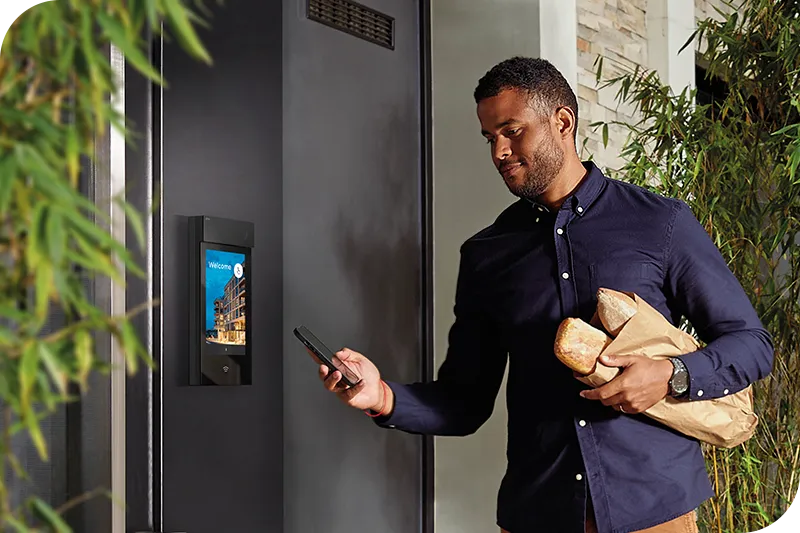Echoes of Innovation: The Evolution of IP Intercoms
 Camilla Ashdown, 10. 06. 2023 | 7 min read
Camilla Ashdown, 10. 06. 2023 | 7 min read
Discover the rich history and evolution of IP intercoms, tracing their journey from humble beginnings to the cutting-edge solutions of today.

From telephones to mobile access control: the evolution of communication
In an increasingly interconnected world, communication is the backbone of our society. Whether it's for security, convenience, or simply staying connected, the ability to communicate effortlessly has become a fundamental part of our daily lives. One technology that has played a pivotal role in this evolution is the IP intercom, a device that has transformed the way we interact and communicate. But where did it start?
Where did it all begin?
The concept of intercoms, or intercommunication systems, can be traced back to the late 19th century when inventors like Alexander Graham Bell and Thomas Edison experimented with early versions of intercoms that used telegraph wires for communication.
Early intercom systems were essentially just communication devices. They relied on basic circuitry, and, unlike the IP intercoms 2N develop today, these devices were not intended to act as a form of access control that restricts access to buildings, but rather as a communication system that allowed people in different rooms of a building to converse without shouting or physically moving between rooms.
The earliest door intercoms were simple, manually operated systems. They typically consisted of a button or buzzer at the front door and a speaker or telephone-like device inside the building which was very rudimentary in design.
Early Analogue Intercoms
The introduction of electricity in the late 19th and early 20th centuries led to the development of more sophisticated intercom systems. These systems utilized electrical wires for the first time to carry voice signals, resulting in clearer and more reliable communication.
In some cases, telephone lines were repurposed for intercom communication within larger buildings or campuses, however, apart from wealthy individuals who were able to afford intercoms for their large homes, the earliest versions were intended for (and more commonly used in) commercial use cases, such as in factories where faster communication between rooms and at entrances was key to efficiency.
The intercom systems that we know: door control
Intercom systems soon developed beyond offering only communication at the front door – soon, they were able to connect to the electric lock installed on the doors. These locks were (and still are to this day) wired to the intercom and, through this connection, could now unlock the door without the person inside needing to be physically present. This unlocking action can either occur when the visitor presents a valid access credential to the intercom (such as a PIN code, or RFID card) – or when the homeowner authorises the visitor from inside their indoor station.
The Digital Revolution
The advent of digital technology in the late 20th century paved the way for significant advancements in intercom systems. Digital intercoms offered clearer audio and more features than the analogue intercoms that came before, and they also introduced the possibility of integrating video, taking communication to a new level. However, they still relied on dedicated wiring and lacked the flexibility that modern IP intercoms offer.
2N Develops the World’s First IP Intercom
The turning point in the evolution of intercoms came with the rise of the Internet and the development of Internet Protocol (IP) technology. IP intercoms, also known as networked intercoms, transformed the communication landscape by leveraging existing network infrastructure. This marked the beginning of a new era in intercom technology – and in 2008, 2N developed the world’s first IP intercom!
The 2N® IP Vario (at that time called 2N® IP Helios) kickstarted a boom of IP-based technology in the intercom sector. Compared to our current range of intercoms, the device was simple – but that didn’t make it any less beautiful in its innovation and reliability. In fact, the 2N® IP Vario is still being used in some of the first projects it was installed in over 10 years ago!
The IP technology 2N pioneered offers installers and users several advantages:
Advanced features
IP technology has opened up a world of new features in intercoms. 2N has come a long way since the first model of the 2N® IP Vario – our most advanced IP intercoms now offer Full HD cameras, QR code reading, mobile access control, Bi-Directional video communication, 10’’ touchscreens, and more!
Endless integration
These systems can be seamlessly integrated with other IP-based technologies, such as surveillance cameras, access control systems, home automation platforms, and third-party security systems. This means the IP intercom can work as part of a full access control solution for residential complexes, offices, or buildings that combine both.
Scalability
IP technology means flexible solutions. You can add new IP intercoms (and other IP access devices) to existing solutions without needing to change cabling. IP intercoms are also scalable in and of themselves, as they usually come with their own firmware, such as the 2N OS, which can be updated regularly to ensure devices have the best features without needing to be replaced.
Cloud-Based convenience
Cloud computing transformed the IP intercom landscape by offering centralized management and remote access to intercom systems.
Property managers and integrators can now, thanks to cloud-based platforms such as the My2N Management Platform, access their IP intercoms from anywhere in the world – which means updates and maintenance can be performed remotely, reducing the need for on-site technicians.
Cloud-based platforms also allow for great options in terms of IP intercom installation. Cloud-based calling between the intercom at the door and answering unit in apartments means that installers can bring all the best modern features to buildings with legacy cabling or no cabling.
Mobile phone access control: the ultimate modern feature
As the 21st century progressed, IP intercoms found their way into the mainstream – into people’s homes, and places of work. This meant that they had to offer something new, something that gives amazing convenience along with security benefits to people’s homes. How? The logical leap in this phone-obsessed modern world was mobile access control.
IP intercoms can now allow users to enter buildings using their phones thanks to mobile credential access control – and Bluetooth mobile access control technology such as 2N’s patented WaveKey is fast becoming a replacement for the RFID cards that were developed in the early 1970s.
Homeowners can also use their phones for something else - thanks to mobile apps such as the My2N app, they can remotely answer their front door, grant access to visitors, and even monitor their property via the IP intercom’s video feed.
From their humble beginnings as basic room-to-room communication devices, IP intercoms have evolved into sophisticated devices that enhance security, convenience, and connectivity. We like to think that 2N has played a very important role in this evolution!
As technology continues to advance, the future of IP intercoms holds the promise of even more innovative and seamless communication solutions. Whether in residential settings, commercial spaces, or industrial complexes, IP intercoms have become an integral part of our interconnected world, shaping the way we communicate and interact.